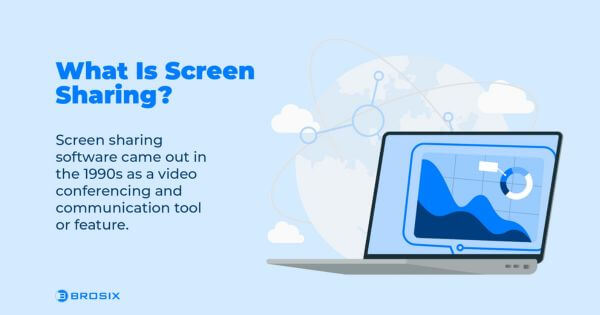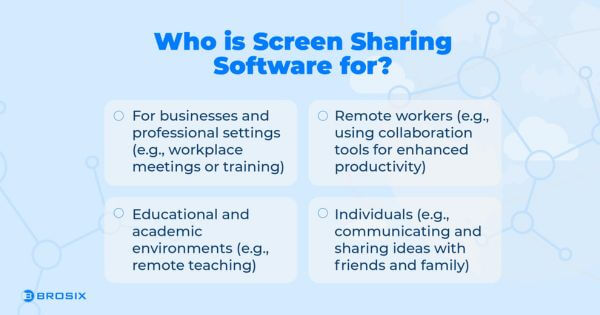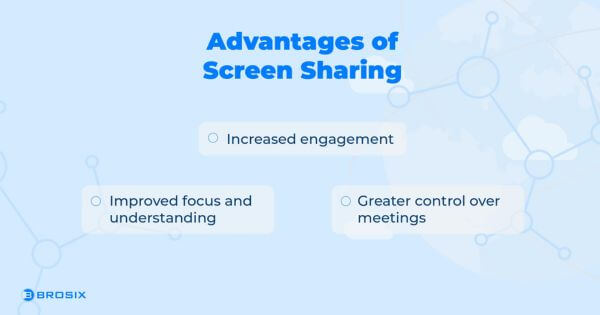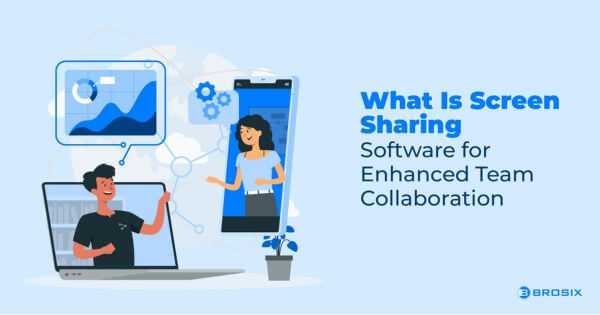In our digitally connected world, you’ll often hear requests to share your screen. This is especially true if you and the individuals you are meeting online are geographically dispersed or working remotely.
But what does the term mean? What are its advantages? What is it used for? And is screen sharing online safe?
In this post, we cover the answers to all these questions to help you get familiar with the concept of screen sharing and how to ensure your safety online.
Let’s begin.
Screen Sharing (Key Takeaways)
- Screen sharing is a technology that allows individuals to display their entire screen or a specific window on their devices to others in real time during online meetings.
- Screen sharing is highly beneficial for various groups. It acts as a versatile solution for enhanced communication and engagement across different contexts.
- This technology improves focus and understanding in meetings by allowing presenters to direct participants’ attention to specific parts of their presentations.
- To ensure safe and secure screen sharing, it is crucial to use secure platforms with features like encryption while following security best practices.
What Is Screen Sharing?

To answer the question “What is screen share?”, let’s unpack the definition first, followed by understanding how it works and who it is for.
Definition
If you’ve asked yourself the questions “What is screen sharing software?” and “When did screen sharing come out?” you’ve come to the right place. Screen sharing software came out in the 1990s as a video conferencing and communication tool or feature.
Instead of sending screenshots and doing file transfers one by one, this technology enables individuals to share an entire screen or specific window on their computer in real time with other participants. It’s a common practice during online meetings.
When you share a screen online, you can present documents, slide decks, a specific browser tab, an application, a file, and more.
Ultimately, the contents of one screen are broadcast to the screens of other devices, and other participants can see what you are doing on your screen. With screen sharing apps and software, you showcase your screen on others’ devices.
How do you screen share?
For those who want to know how to share a computer screen, it’s necessary to first have screen sharing software installed on your computer. It can be an app or browser-based.
It is also necessary for the rest of the participants to have the same software installed on their computers or devices.
Next, the user establishes an online meeting or connects with other users online, followed by activating the screen sharing function. After this, the presenting user will be prompted to select which window or screen they would like to share.
Once the selection has been made, the other participants will see the presenter’s broadcasting screen and all its contents on their own receiving devices.
Who is screen sharing software for?

Having looked at how to screen share, let’s explore who it is ideal for. As a versatile solution, screen sharing is great in many situations, including:
- For businesses and professional settings (e.g., workplace meetings or training)
- Remote workers (e.g., using collaboration tools for enhanced productivity)
- Educational and academic environments (e.g., remote teaching)
- Individuals (e.g., communicating and sharing ideas with friends and family)
Advantages of Screen Sharing

When you screen share online in a professional setting, you can enjoy several distinct advantages.
Here are the top three benefits of sharing a screen:
Improved focus and understanding
When you share your screen online with meeting participants, you can guide their attention to specific parts of your presentation, file, browser, or document. This leaves everyone on the same page and fosters improved understanding. With visual aids and cues, you can actively show rather than tell what you are referring to, helping the more visual learning-inclined participants to understand better.
Greater control over meetings
Sending a presentation to participants before a meeting doesn’t guarantee that everyone will fully grasp it. By screen sharing and going through your specific document step by step, you can create a more organized and controlled experience for everyone involved. This helps stick to time limits better, reduces confusion, and ensures that meetings are conducted with the right collaboration techniques in mind.
Increased engagement
With screen sharing online, you also empower teams to share data, demonstrate software processes, and dynamically collaborate. All this in real time. It’s a great way to increase engagement, especially if you are dealing with complex, visually-oriented data. By highlighting the key points in your presentation, you have a chance to keep people interested. Also, it beats describing a visual process in words, which is quite inefficient, and therefore screen sharing makes teaching, troubleshooting, and other important activities more manageable.
Use Cases for Screen Sharing
Wondering when and in which situations screen sharing is useful?
Here are six common use cases where it plays a particularly important role:
1. Virtual meetings and updates
Virtual meetings are becoming commonplace in our modern times. They are used for a variety of purposes, such as team huddles where tasks and projects are organized. They can also be used for morning scrums to address day-to-day problems. Managers and business leaders can also benefit from virtual one-on-one or group meetings, as this is a great space to define business strategies and make decisions.
Exchanging information and knowledge is also great for project updates, while managers and team members can also use the functionality for performance reviews. Furthermore, screen sharing during virtual meetings facilitates the coordination of various issues that influence growth and organizational development.
2. Remote team collaboration
With the proliferation of remote work, teams are increasingly looking for secure and reliable ways to collaborate and communicate. Through remote work communication solutions, common challenges and uncertainties are easily addressed. Examples include cybersecurity challenges such as malware threats, cyberattacks, and data breaches.
However, with the right screen sharing and instant messaging software for businesses, it’s never been easier or safer to collaborate with your remote team members than it is today. Replicating an in-person meeting, it’s now possible to brainstorm and engage in virtual problem-solving activities, take notes, and share visual aids to facilitate communication, greater efficiency, and improve team performance.
3. Presentations, trainings, and webinars
There are many reasons why presentations are important in business and professional environments. They can be used to update teams on the latest company news or a new strategy, help outline a marketing or sales campaign, present financial figures to stakeholders, etc. In each of these cases, screen sharing plays a key role in keeping everyone on track.
Furthermore, screen sharing enables businesses to carry out employee training to ensure that their most valuable asset—their employees—are equipped with the right skills, knowledge, and tools to be productive and successful. Finally, screen sharing is the ultimate way to hold informative webinars that are great for boosting your thought leadership as an industry authority or onboarding new clients.
4. Remote customer support
Especially useful for businesses that provide software-as-a-service (SaaS) solutions or those that offer services that need strong customer support, screen sharing has become the go-to answer for effective remote support.
Whether it’s demonstrating how to use a piece of software or helping a customer on the other side of the screen, it becomes easier and much more efficient to see the challenge that a user may be facing as opposed to having it explained in words. With screen sharing, seeing the problem first-hand enables faster issue resolution and better customer service and technical support.
5. Job interviews
Human resources (HR) teams also benefit greatly from screen sharing software for their workflow automation. Juggling a broad array of tasks such as performance reviews, handling employee timesheets, managing employee information and leave requests, and employee onboarding and offboarding, HR professionals need the right tools to carry out their functions efficiently.
Another area where screen sharing takes center stage is in job interviews. It offers both parties the chance to showcase what each one brings to the table. An HR professional carrying out an interview can show the agenda for the meeting and pertinent information about the company and the role.
Meanwhile, a candidate can showcase their CV or demonstrate the steps they took to complete a task or showcase their portfolio. Overall, screen sharing and instant messaging for HRs is an essential part of their toolkit for more efficient and productive work.
6. Product demos and sales pitches
And last but not least, screen sharing plays an essential role in performing product demos and sales pitches. For product demos, screen sharing makes it easier to engage a potential buyer.
As most people better respond to and absorb visual information, showcasing how a product works will enable them to understand its value. With so many people pressed for time, you can use the opportunity to show the product in action and answer questions, all without them having to leave their office.
The same is true for sales pitches where prospects are short on time and want a quick and visually appealing way to understand what they’re buying. Screen sharing offers this opportunity and enhances business objectives. Screen sharing offers this opportunity and enhances business objectives.
How to Use Screen Sharing Within the Brosix Instant Messenger
Screen sharing with Brosix is highly intuitive, convenient, and secure. In three simple steps, you’re on your way to boosting team productivity and improving work efficiency by presenting or viewing another user’s screen.
Here’s how it works:
- Select a contact from your contact list
- Click on the “Screen Sharing” icon
- Select the type of session (Present or View)
With the “Present” option, you can choose to either “Show my screen” or “Show my screen and give remote control.”
Alternatively, with the “View” option, you can select either “View remote screen” or “View remote screen with remote control.”
Safety and Security Tips for Screen Sharing
With online security being of paramount importance for every organization, it’s important to ask questions like “Is screen sharing detectable?” and “Is screen sharing dangerous?”
Regarding detection, the answer is that yes, screen sharing can be detectable, depending on the screen sharing platform you are using. As for any associated dangers, these can be mitigated if you use the right secure software and introduce safety protocols to your teams.
Ultimately, with screen sharing, you want to follow these three best practices for enhanced security:
- Use secure platforms: Platforms like Brosix offer peer-to-peer connections and encryption for the highest levels of security, and none of your data will reach unwanted or unauthorized third parties.
- Limit what is shared on screen: Share only what is relevant to the presentation or topic. Avoid sharing any personal or sensitive business information online.
- Regularly update security software: Regularly update your security software to ensure you use the latest version with the most recent updates to keep your information safe.
Conclusion
It’s undeniable that screen sharing has become an integral part of many organizations’ processes across the globe.
Screen sharing is essential for various purposes, including virtual business meetings, enhancing HR practices, and boosting remote customer support. It is indispensable for improved productivity, efficiency, and collaboration.
Whether you’re meeting with prospective clients or new employees from different parts of the world, secure screen sharing is the modern solution to geographical barriers.
FAQ
What is the difference between screen sharing and screen mirroring?
The main difference between screen sharing and screen mirroring lies in their functionality. Whereas screen sharing allows for interaction with the shared content (where users can see changes as they occur), screen mirroring only displays the content on the original device without allowing for interactions from other users on the mirrored display. Mirroring is about displaying content rather than collaborating on it and is typically used in classrooms and meetings without interactions.
Why does screen sharing sometimes lag during usage?
In screen sharing, the broadcasting device encodes an image of its screen contents and transfers it over the receiving device’s network. This device then decodes the image and displays it on its screen. Depending on the network connection’s strength and speed, lags are possible, and image quality may also vary. However, such lags are often not long enough to cause a significant disruption.
How much data does screen sharing use?
If you are wondering “Does screen sharing use data?” the answer is yes. As for the amount of data being used, it can range from 0.04 Mbps to 2.5 Mbps. The usage quantity will depend on the size and the rate of the changes on the screen.
